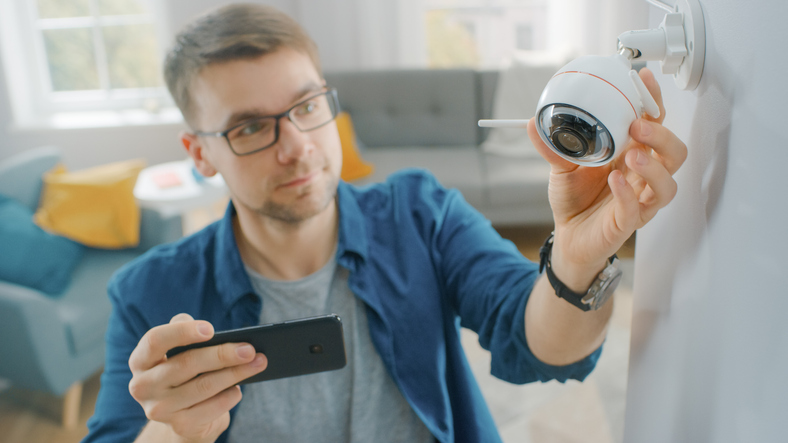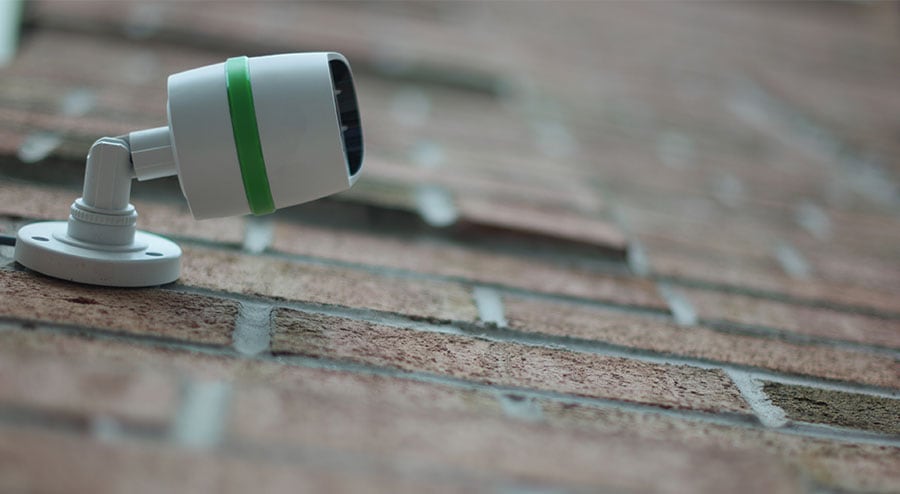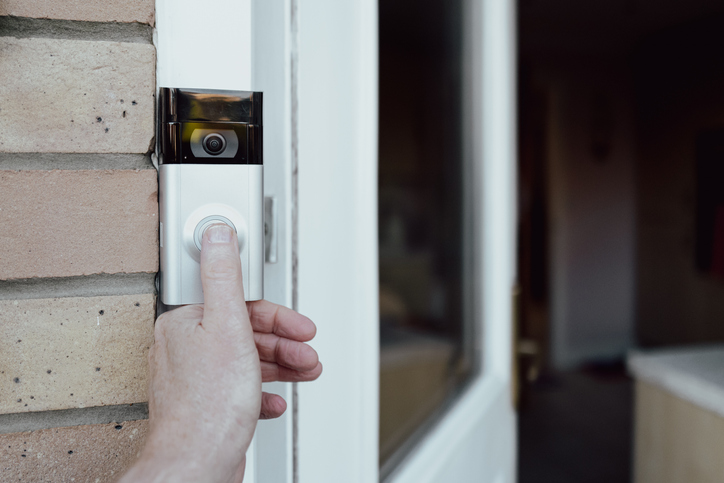How Wireless Home Security Cameras Work
Wireless home security cameras utilize wireless technology to transmit video and audio signals without the need for physical cables. They rely on wireless communication protocols such as Wi-Fi or Bluetooth to send the captured footage from the camera to a receiver or a central hub. This wireless transmission allows for flexibility in camera placement and eliminates the need for extensive wiring throughout the home.

Components Involved
Wireless home security cameras consist of several key components that work together to capture, transmit, and view video and audio footage. The primary component is the camera itself, which includes a lens, image sensor, and processing unit. The camera is responsible for capturing high-quality video and audio data. It may also incorporate additional features such as night vision for clear imaging in low-light conditions, motion detection to trigger recordings upon detecting movement, and two-way audio communication for interactive monitoring.
To enable wireless transmission, the camera is equipped with a built-in transmitter. This transmitter encodes the video and audio signals into a wireless format, typically utilizing communication protocols like Wi-Fi or Bluetooth. The encoded data is then transmitted wirelessly to a receiver. The transmitter packages the signals into data packets that are sent over the airwaves.
The receiver serves as the counterpart to the camera’s transmitter. It receives the wireless signals and decodes them back into a usable video and audio format. The receiver is usually connected to a viewing device such as a monitor, computer, or smartphone, allowing users to view the captured footage in real-time or review it later. The receiver acts as the central hub that receives and processes the signals from multiple wireless cameras, consolidating the feeds into a single interface for convenient monitoring.
Choosing The Right Wireless Home Security Camera
By considering important features, such as resolution, field of view, night vision, weatherproofing, integration with smart home devices, battery life, and storage options, you can choose the right wireless home security camera that aligns with your specific requirements and provides effective monitoring and protection for your home.
Special Features Of Home Security Cameras
There are many features that are integrated into home security cameras, such as camera resolution, field of view, night vision, and weatherproofing. These can have a big impact on the system you choose.
The resolution of a wireless home security camera refers to the number of pixels it can capture in each frame of video. Higher-resolution cameras provide clearer and more detailed images, allowing for better identification of objects and individuals. Common resolution options include HD (720p), Full HD (1080p), and Ultra HD (4K).
The field of view (FOV) determines the area that a camera can cover. It is typically measured in degrees and determines the width and height of the captured scene. A wider field of view is beneficial for monitoring larger areas, such as expansive yards or open living spaces. Cameras with adjustable or wide-angle lenses offer greater flexibility in capturing a broader field of view.
Night vision capabilities are crucial for wireless home security cameras, as they enable clear monitoring in low-light or nighttime conditions. Cameras equipped with infrared (IR) LEDs or low-light sensors can capture detailed black-and-white footage even in complete darkness. The range and quality of night vision vary among cameras, so it’s important to consider the specific needs of your home.
If you plan to install wireless home security cameras outdoors, it’s vital to choose models that are weatherproof. Look for cameras with an IP (Ingress Protection) rating, which indicates their resistance to dust and water. Higher IP ratings, such as IP65 or IP66, ensure that the cameras can withstand various weather conditions, including rain, snow, and extreme temperatures.
Battery Life And Storage Options For Recorded Footage
When choosing a wireless home security camera, consider the battery life to ensure continuous monitoring without frequent recharging or battery replacements. Look for cameras with battery life ranging from 3 to 12 months, depending on usage and settings. Some advanced cameras may offer extended battery life by utilizing power-saving features like motion-activated recording or low-power standby modes. Camera systems like Ring also offer additional solar charging components.
Wireless home security cameras offer different storage options for recorded footage. Local storage typically involves using a microSD card with varying storage capacities, such as 32GB, 64GB, or 128GB. These cards can store several days or weeks of footage, depending on the camera’s resolution and video compression settings.
Alternatively, cameras with cloud storage capabilities upload the recorded footage to remote servers over the internet. Cloud storage subscriptions often provide a range of plans with different storage capacities, such as 7-day, 14-day, or 30-day storage plans. The available storage capacity can vary from a few gigabytes to terabytes, depending on the subscription level.
Installation And Setup
By following the installation steps and considering optimal camera placement, you can maximize the effectiveness of your wireless home security cameras. Well-placed cameras provide comprehensive coverage, act as a deterrent, minimize blind spots, and ensure the privacy of both your property and surrounding areas.
Steps For Installing Wireless Home Security Cameras
Determine camera placement: Before installing your wireless home security cameras, carefully consider the areas you want to monitor. Identify vulnerable points such as entrances, windows, or areas with valuable assets. Ensure that the chosen locations provide optimal coverage and minimize blind spots.
- Check wireless signal strength – Prior to installation, verify the wireless signal strength in the desired camera locations. Weak or unstable signals can lead to connectivity issues and unreliable footage. Place the camera temporarily in the intended position and check if it maintains a stable connection with the receiver or hub.
- Mounting the camera – Follow the manufacturer’s instructions for mounting the wireless home security camera. Most cameras come with mounting brackets, screws, and adhesive options. Ensure the camera is securely attached to the chosen surface, whether it’s a wall, ceiling, or other suitable location. Take care to align the camera to achieve the desired field of view and angle.
- Power source – Depending on the camera model, connect the camera to a power source. Some wireless cameras are battery-powered, while others require a direct power connection. If your camera uses batteries, insert them according to the manufacturer’s instructions. For cameras that require a power outlet, ensure the power source is conveniently accessible.
- Pairing and configuration – Once the camera is mounted and powered, follow the provided instructions to pair and configure the camera with your network or receiver. This typically involves connecting the camera to your Wi-Fi network using a smartphone app or web portal. Enter the necessary network credentials, such as SSID and password, to establish a secure connection.
- Testing and adjustments – After the initial setup, test the camera’s functionality by accessing the live feed on your viewing device. Make any necessary adjustments to the camera’s position or settings to optimize the field of view, resolution, or motion detection sensitivity. Test the camera’s motion detection capabilities by walking in its field of view to ensure it triggers recordings accurately.
Importance Of Camera Placement
Optimal camera placement is of paramount importance when it comes to maximizing the effectiveness of your wireless home security system. By strategically positioning cameras to cover critical areas, minimize blind spots, and deter potential intruders, you can enhance the overall surveillance capabilities and ensure comprehensive coverage of your property.
Optimal camera placement ensures comprehensive coverage of the desired areas. Strategically positioning cameras provides visibility of entry points, walkways, driveways, and other critical areas of your property. By covering these areas effectively, you enhance the chances of detecting and recording any suspicious activities or intrusions.
Visible placement of cameras can act as a deterrent to potential intruders. When cameras are clearly visible, they convey the message that the property is being monitored, which can discourage criminals from attempting unlawful activities. Careful placement of cameras helps minimize blind spots, which are areas that are not within the camera’s field of view. Analyze the layout of your property and consider potential obstructions, such as walls, furniture, or landscaping, that could impede the camera’s coverage. By eliminating or reducing blind spots, you ensure comprehensive surveillance coverage.
The height and angle of the camera significantly impact its field of view. Mount the camera at a suitable height that provides an unobstructed view of the area you want to monitor. Consider the camera’s viewing angle and adjust the tilt or rotation to capture the desired coverage area effectively. Install cameras out of reach or in secure housing to prevent tampering or vandalism. This may involve mounting cameras higher or using protective enclosures designed to deter tampering attempts. Ensuring the cameras are not easily accessible enhances their reliability and longevity.
While it is essential to achieve optimal coverage, it’s crucial to respect the privacy of individuals within the camera’s range. Avoid positioning cameras in areas where they may capture sensitive areas like bedrooms, bathrooms, or neighboring properties. Be mindful of privacy laws and regulations governing the use of surveillance cameras in your region.
Remote Access And Monitoring
Most wireless home security cameras come with dedicated mobile apps or web portals that provide seamless access to the camera feeds so you can monitor them remotely. These apps can be downloaded onto your smartphone or tablet, allowing you to view the live video stream, playback recorded footage, and adjust camera settings remotely. Web portals offer similar functionalities through a browser interface on your computer.
To access the cameras remotely, you need to connect them to your home’s Wi-Fi network. During the initial setup process, you will typically configure the camera to connect to your Wi-Fi network by entering the network credentials (SSID and password). This establishes a connection between the camera and your home network, enabling remote access capabilities.
Remote access relies on a stable and reliable internet connection. Ensure that both your viewing device and the camera system have access to a reliable internet connection, either through Wi-Fi or mobile data. A high-speed internet connection is recommended for smooth and uninterrupted streaming of the video feed.
Deterrence And Prevention
Wireless home security cameras serve as effective deterrents to potential intruders due to their visible presence. When strategically positioned and clearly visible, these cameras send a strong message that the property is under surveillance. The knowledge that their actions may be captured on camera and used as evidence makes would-be criminals think twice before targeting such properties. The visual deterrent aspect of wireless cameras plays a crucial role in deterring intruders and reducing the risk of criminal activity.
Motion Detection And Alerts For Deterring Suspicious Activities
Wireless home security cameras equipped with motion detection capabilities further enhance deterrence and prevention measures. These cameras can detect motion within their field of view, triggering real-time alerts to homeowners. The immediate response enabled by motion detection allows homeowners to take prompt action, such as contacting authorities or remotely accessing the camera feed to assess the situation. This proactive monitoring and quick response disrupt the intentions of potential intruders and increase the chances of their apprehension.
Motion detection allows homeowners to review recorded footage specifically triggered by motion events, providing valuable evidence and insights into suspicious activities. By leveraging motion detection features and receiving timely alerts, wireless home security systems effectively deter potential intruders, minimize the risk of criminal activity, and provide homeowners with a heightened sense of security and peace of mind.
Privacy And Security Considerations
When installing wireless home security cameras, you need to also understand local privacy laws to make sure you’re not violating the protection of personal information and respect for privacy rights. By taking appropriate measures, homeowners can strike a balance between effective security and maintaining privacy.
Transparently communicate the presence of security cameras to individuals who may be captured within their field of view. This can include notifying neighbors, guests, or service providers about the presence of cameras and their purpose. Clear signage indicating the use of surveillance can also help alert individuals to the presence of cameras.
Vacation Homes
When installing wireless home security cameras in an Air B n B property, it is crucial to understand and adhere to local privacy laws and regulations. By transparently communicating the presence of security cameras to guests and taking appropriate measures to protect privacy, hosts can strike a balance between effective security and maintaining guest privacy.
To comply with legal requirements, hosts should research local laws, notify guests about the cameras through clear signage, and respect guests’ privacy in private areas. It is important to have a clear purpose for camera usage, protect recorded footage through secure storage and access controls, establish retention policies, and limit access to authorized individuals. By adhering to these guidelines, hosts can ensure compliance with privacy laws while maintaining a secure and respectful environment for guests in their Air B n B property.
Legal Considerations
Familiarize yourself with local laws and regulations regarding the use of surveillance cameras. Laws can vary significantly between jurisdictions, so it is important to understand the specific rules that govern your area. Look into regulations related to camera placement, recording in public areas, audio recording, and the use of footage as evidence.
Be aware of any restrictions on recording public areas, as privacy laws may prohibit capturing footage of individuals in locations where they have a reasonable expectation of privacy, even if it is visible from public spaces. Understanding the limitations of recording in public areas can help ensure compliance with privacy regulations.
Be mindful of privacy rights and respect the privacy of individuals captured by the cameras. Avoid placing cameras in areas where individuals have a reasonable expectation of privacy, such as bedrooms, bathrooms, or neighboring properties. Minimize capturing footage beyond the boundaries of your property to respect the privacy of others.
Importance Of Secure Connections
Protect your home Wi-Fi network with a strong and unique password. A secure Wi-Fi network prevents unauthorized access to your camera system and the footage it captures. Choose wireless home security cameras that support secure communication protocols such as SSL/TLS encryption. This ensures that the data transmitted between the cameras and your viewing device is encrypted and protected from interception or unauthorized access.
If you plan to access the cameras remotely, use secure methods such as VPN (Virtual Private Network) connections or two-factor authentication to further enhance the security of your remote access. These measures add an extra layer of protection, preventing unauthorized access to the camera feeds and system settings.
Tips For Maintaining Privacy And Securing The Camera System
In addition to addressing privacy concerns and ensuring secure connections, there are several best practices to maintain privacy and enhance the security of your wireless home security camera system.
Keep your camera’s firmware up to date by regularly checking for and applying manufacturer-released updates. Firmware updates often include security patches and bug fixes that address vulnerabilities and ensure optimal system performance. Use strong, unique passwords for both your camera system’s admin account and your home Wi-Fi network. Avoid using default or easily guessable passwords. A strong password should include a combination of letters (both uppercase and lowercase), numbers, and special characters.
Review the camera’s settings and disable any features that are not needed or may compromise privacy. For example, disable audio recording if it is not necessary for your surveillance needs. Routinely monitor your camera system to ensure that it is functioning properly and that there are no unauthorized access attempts. Regularly review the camera feeds and stored footage to identify any suspicious activities or potential security breaches.
Cost And Maintenance Of Home Security Cameras
The cost of wireless home security cameras can vary depending on several factors, including brand, features, resolution, and additional capabilities. It is important to consider the cost range when selecting a camera system that aligns with your budget and security needs.
Cost Of Home Security Cameras
Entry-level wireless home security cameras from brands like Wyze, Blink, and Zmodo generally range from $50 to $150 per camera. These cameras offer basic features such as HD resolution, limited field of view, and standard motion detection. They are suitable for users on a tight budget or those looking for cost-effective solutions.
Mid-range wireless cameras from reputable brands like Arlo, Ring, and Eufy fall in the price range of $150 to $300 per camera. These cameras often offer higher resolutions, wider field of view, enhanced night vision capabilities, and additional features such as two-way audio communication or integration with smart home devices. They strike a balance between affordability and advanced functionalities.
High-end wireless home security cameras from brands like Nest, Axis Communications, and Hikvision can range from $300 to $500 or more per camera. These cameras usually offer superior image quality with higher resolutions like Full HD or Ultra HD, wider field of view, advanced night vision, and advanced motion detection capabilities. They often incorporate advanced features like facial recognition, object tracking, or advanced integration with home automation systems.
Potential Additional Expenses
Some camera systems offer cloud storage options for storing recorded footage. Cloud storage subscriptions typically range from $5 to $30 per month, depending on factors such as storage capacity and the duration of footage retention. Higher-tier subscription plans may offer extended storage periods or additional features like advanced video analysis. Evaluate your storage needs and compare subscription plans to select the one that best fits your requirements and budget.
Certain wireless camera systems provide the option for professional monitoring services, which involve a monthly fee. Professional monitoring services can range from $10 to $50 per month, depending on the provider and the level of service. These services offer 24/7 monitoring of your camera feeds and can dispatch emergency responders if suspicious activities or emergencies are detected. Assess the level of monitoring you require and compare the costs and benefits of different service providers.
Depending on your specific needs and preferences, there may be additional accessories or add-ons that incur extra costs. For example, outdoor mounting brackets, extension cables, or solar panels for powering wireless cameras can range from $10 to $50 or more, depending on the brand and quality. Assess your installation requirements and consider any additional accessories that may be necessary to optimize camera placement and performance.
Maintenance Requirements
If your wireless cameras are battery-powered, they will require periodic battery replacement. The frequency of battery replacement varies depending on factors such as camera usage and battery capacity. Rechargeable batteries for wireless cameras typically range from $10 to $40 per battery, depending on the brand and quality. It’s advisable to invest in high-quality rechargeable batteries to minimize long-term expenses.
Manufacturers release firmware updates for wireless cameras to enhance performance, address security vulnerabilities, and introduce new features. Firmware updates are typically provided free of charge by the camera manufacturer. Regularly check the manufacturer’s website or mobile app for firmware updates specific to your camera model. Firmware updates can usually be downloaded and installed easily, ensuring your camera system remains up-to-date with the latest improvements.
Proper cleaning and upkeep of your wireless home security cameras are essential for optimal performance. Use a soft, lint-free cloth to clean the camera lenses regularly and remove any dirt or smudges. Additionally, inspect outdoor cameras periodically for dirt, debris, or spider webs that may affect image quality. Cleaning supplies like lens cleaning kits can be purchased for around $10 to $20, ensuring proper maintenance without risking damage to the camera lens.
Conclusion
Wireless home security cameras offer a convenient and effective solution for monitoring and deterring potential intruders. With their wireless technology, easy installation, and remote access capabilities, these cameras provide homeowners with peace of mind and enhanced security. By considering factors such as camera placement, features, privacy concerns, and maintenance requirements, individuals can make informed decisions when choosing and implementing a wireless home security camera system. With monitoring and deterrence made easy, wireless home security cameras are an invaluable tool in protecting your home.




